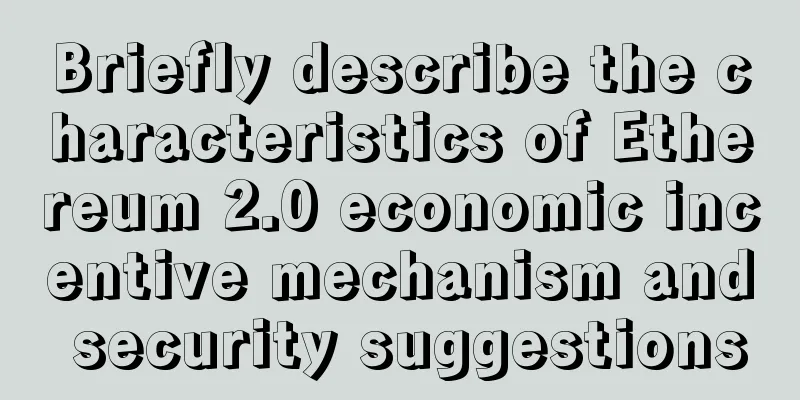Briefly describe the characteristics of Ethereum 2.0 economic incentive mechanism and security suggestions

|
Original title: "Viewpoint | A brief summary of the ETH 2.0 economic model analysis report" In March 2020, we received funding from MolochDAO to research the economic model of ETH 2.0. This investigation was originally in response to a call for proposals: Since then, we have been working hard to analyze the ETH 2.0 network and its PoS-based economic incentive mechanism. Our conclusions are based on our own research. We built an economic model to reflect the inputs and outputs of the ETH 2.0 network and interviewed many stakeholders representing the main players in the Ethereum ecosystem. We have compiled all of our findings into the following report: ETH 2.0 Economic Review: Analysis of Ethereum PoS Incentive Model We would like to thank MolochDAO, the people we spoke with, and the Ethereum Foundation for their support of this project. Special thanks to Danny Ryan, Barnabe Monnot, Trent Van Epps, and Vitalik Buterin for their comments and suggestions on the initial draft. While we highly recommend reading the full report, we’ve included a summary below. If anyone has any questions, please reach out to us on Twitter — @thomasborgers and @tehoban1 — PMs are welcome! The ETH 2.0 network upgrade is a gradual move towards the grand goal of the PoS consensus algorithm and incentive mechanism. In turn, the PoS incentive mechanism has a profound impact on the economic properties of the Ethereum network. The design of the PoS incentive mechanism is very complex - on the one hand, it is necessary to reward honest participants who verify transactions and finalize the historical state of the network, and on the other hand, punish those offline or malicious validators. In this paper, we use a sophisticated economic model and a new economic evaluation tool to define, measure, and analyze the cryptoeconomic security of ETH 2.0. First, to facilitate the study of the economic model of Eth2.0, we used Excel to build an economic model to explain the output of the ETH 2.0 system under current specifications and specific scenarios. Throughout the project, we gradually developed and used this model to calculate expectations and draw conclusions about validator income, costs, benefits, and currency issuance based on data. In the ETH 2.0 system, there are nearly 100 variables that have a significant impact on the output value. Through this model, we dynamically show the impact of ETH price changes and the total amount of ETH staked on validator income, highlighting the impact of variables on network security. We defined the level of economic security that ETH 2.0 Phase 0 must achieve using a series of assumptions around the cost of attacking the network. This level of security is meant to make the cost of an attack higher than the potential benefit of an attack, and to give ETH 2.0 Phase 0 the same level of security as ETH 1.0 (the current Ethereum blockchain). We identified two main categories of economic attack vectors. Each of these attack vectors has different variants and different levels of risk: Supermajority Attacks and Finality Attacks. In Phase 0, we focus primarily on attacks that are intended to destroy the network. We find that the network is at risk of these attacks in Phase 0, but we are more concerned about subsequent phases. Based on the historical price and hashrate of ETH, we estimate that a staking rate of 13.8% provides adequate security. The security of ETH 2.0 is tied to the amount of ETH staked, which itself is a function of returns. We built a model to understand the motivations of investors who are committed to high capital utilization. We call it RSAVY (Required Serenity Active Validator Return) model, which is used to determine the risk and cost issues of staking, and the corresponding required rate of return (RRR). Based on our results, we expect that in an optimized (endogenous and exogenous) network, the required rate of return (i.e., minimum rate of return) must be at least 3.3% before validators will consider joining the network. In a bearish but stable market environment, the required rate of return increases to 11.6%. In addition to calculating the required rate of return, the RSAVY model can also be used to outline the overall picture of the network in specific scenarios. In these scenarios, we use different parameters and come to some conclusions and suggestions, which are detailed below. in conclusion The PoS mechanism of ETH 2.0 is much more complicated than the PoW mechanism. ETH 2.0 is a highly complex and well-thought-out system. This system has been carefully designed and constructed, but it is difficult to understand from the perspective of a validator, resulting in uncertainty and unpredictability, making it more difficult for potential validators who seek capital efficiency to understand. suggestion Increasing the base reward factor to 128 and beyond: We acknowledge that increasing network costs helps improve network security, but with a base reward factor of only 64, we believe the cost the network pays for security is insufficient - it is wise to be cautious during the Ethereum network's transition to a PoS mechanism. |
>>: Today's Recommendation | Bitcoin's Second Half of 2020
Recommend
What does Tan Lang Ming Palace represent?
There are fourteen main stars in the Eight Great ...
Coinbase announces resumption of Bitcoin Cash trading, but BCHSV is on hold
According to ethnews, Coinbase announced on Novem...
The total stake of the Filecoin network is approximately 105.8 million FIL
Filfox browser data shows that the current block ...
People with round foreheads are not suitable for office romances
The forehead plays an important role in physiogno...
Does a man with raised eyebrows have a good personality and appearance? Is he destined to be unlucky in marriage?
Eyebrows are one of the five facial features. Goo...
Can blockchain technology protect bosses' privacy in the Panama Papers?
Rage Commentary : The information leakage of Pana...
How to tell love luck through facial features? What kind of people are most likely to attract love luck?
What kind of face attracts love? Love is an indis...
Is a mole on a man’s philtrum considered an evil mole? What does it mean?
Moles grow on various parts of the human body, an...
After the London hard split, these predictions for Ethereum 2.0 are worth a look
Original title: "After the London Hard Fork,...
The shape of your buttocks determines your life's fortune
The shape of your buttocks determines your life&#...
Which facial expression will ruin your good luck?
Which facial expression will ruin your good luck?...
BTC price halved, 30% of mining machines may be shut down
Text | JX kin Editor | Wen Dao The unprecedented ...
Forehead analysis: the most blessed forehead
Amount of revenue The business forehead has corne...
How can a person with a broken palm have a good marriage?
The lines of a broken palm may be bad for some pe...
What does it mean if a man has a mole under his eye? How to judge whether a mole is auspicious or inauspicious?
It is very common to have moles on the face. So, l...









